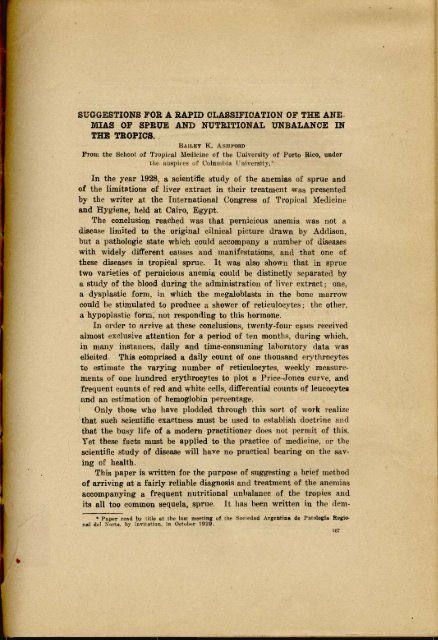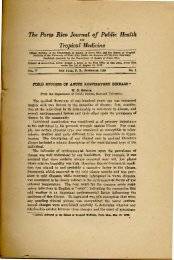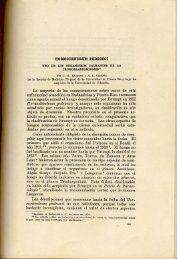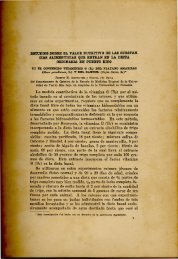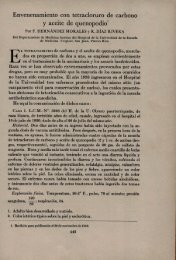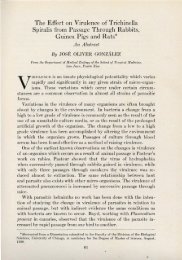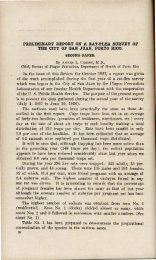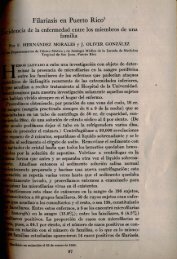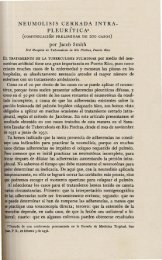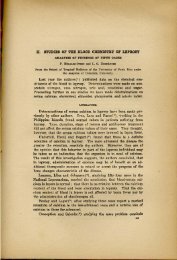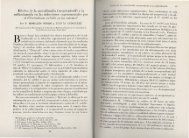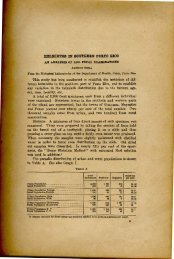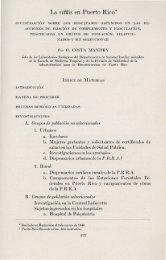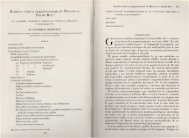Classification of Anemias.pdf
Classification of Anemias.pdf
Classification of Anemias.pdf
Create successful ePaper yourself
Turn your PDF publications into a flip-book with our unique Google optimized e-Paper software.
SUGGESTIONS FOR A RAPID CLASSIFICATION OF THE ANE<br />
l\oIIAS OF SPRUE AND NUTRITIONAL UNBALANCE IN<br />
THE TROPICS..<br />
H ,\ILl:Y K. A S IU'OJ(D<br />
From the Schoo l <strong>of</strong> 'I'ropicul Medil·ine <strong>of</strong> th e Uuivursity <strong>of</strong> Port-o Rico, under<br />
th e auspices <strong>of</strong> Columbia l: niversity. "<br />
In the year 1928, a scientific study <strong>of</strong> the anemias <strong>of</strong> sprue and<br />
<strong>of</strong> the limitations <strong>of</strong> liver extract in their treatment was presented<br />
b)' the writer at the Internati onal Congress <strong>of</strong> Tropica l Medicine<br />
and Hygiene, held at Cai ro, Egypt.<br />
The conclusion reached was that pernicious anem ia was not It<br />
disease limited to the original cilnieal picture drawn by Addison,<br />
but a pat hologic state wh ich could accompany a number <strong>of</strong> diseases<br />
with widely different cau ses and man ifestations, and t hat one <strong>of</strong><br />
these diseases is tropical sprue. It was also show n that in sprue<br />
two varieties <strong>of</strong> pernicious anemia could be distinctly separated by<br />
a study <strong>of</strong> the blood during the administration <strong>of</strong> liver ext ract ; one.<br />
a dysplastic form, in which the megaloblasts in the bone marrow<br />
could be stimulated to produce a shower <strong>of</strong> reti euloeytes , the oth er,<br />
a hypoplast ic form, not responding to this hormone.<br />
I n order to arrive at these conclusions, twenty-fou r eases received<br />
almost exclusive attention for a period <strong>of</strong> ten months, during which,<br />
in many ins tances, daily and time-consuming lab oratory data was<br />
elicited. This comprised a daily count <strong>of</strong> one thousand erythrocytes<br />
to estimate the varying number <strong>of</strong> retieuloeytes, weekly measurements<br />
<strong>of</strong> one hundred erythrocytes to plot a Price-Jones curve, and<br />
,fr equent counts <strong>of</strong> red and white cells, differential counts <strong>of</strong> leucoeytes<br />
and an esti mation <strong>of</strong> hemogl obin percentage.<br />
I Only those who have plodded through this sor t <strong>of</strong> work l'calize<br />
that such scientific exactness must be used to establish doctrin e find<br />
that the busy life <strong>of</strong> a modern pr-actitioner does not permit <strong>of</strong> this.<br />
Yet these facts must be applied to the practice <strong>of</strong> medicine, 01' t he<br />
scientific study <strong>of</strong> disease will have no practical bearing on th e saving<br />
<strong>of</strong> health.<br />
This paper is written for the purpose <strong>of</strong> suggesting a brief method<br />
<strong>of</strong> arriving at a fairly reliable diagnosis and treatment <strong>of</strong> the an emias<br />
accompanying a frequent nutritional unbalance <strong>of</strong> th e tropics and<br />
its aU too common sequela, sprue. 1t. has been written in the dem<br />
• P aper r ead by litl . al the lnal meetinjt <strong>of</strong> lh e<br />
nal dr-l ~ ort •. by in vit nt io n. in Octub{-T 1929 .<br />
oc iedn d Ar jteDtiDa de Pntolor f.. Rejtlo·<br />
107
168 PORTO RICO JOURNAL OF PUBI,IC HEALTH A..~D TROP. MEDICINE<br />
oeratie spirit which should inspire one who attempts to suggest to<br />
his colleagues a plan <strong>of</strong> action which must be feas ible, and which<br />
should at the same time satisfy their scientific scr uples. That is<br />
to say, it opens the door to all over-wor ked physicians to say how<br />
much or how little clinical laboratory work must needs be performed<br />
before it is possible to arrive at ;.a fairly reliable diagnosis and<br />
treatment" <strong>of</strong> these anemias.<br />
The method employed by the writer, with exceptions imposed by<br />
an unusual pressure <strong>of</strong> work, has been as follows:<br />
( - 1. All persons suffering from clinical sprue or its preceding nutritional<br />
unbalance have their hemoglobin percentage estimated by the<br />
Dare instrument (two minutes).<br />
2. All cases with a hemoglobin <strong>of</strong> less than seventy per cent receive<br />
a red cell and <strong>of</strong>ten a white cell count (ten to twelve minutes).<br />
3. All cases coming under thc latter category with a color index<br />
<strong>of</strong> plus 1. or over and with a hemoglobin below fifty per cent, r eceive<br />
in addition a differential count <strong>of</strong> Jeucoeytes and a careful measurement<br />
<strong>of</strong> ten erythrocytes in a field enabling one to take these ten<br />
cells as they come, one after the other in the same traverse, without<br />
selecting cells that are interestingly large or small (a dangerous<br />
pitfall for an honest average). 'I'hese measurements should be made<br />
with the best filar eye-piece micrometer obtainable ; that is to say, one<br />
which will distinguish one-tenth <strong>of</strong> a micron. In addition, this must<br />
always be supplemented by a count <strong>of</strong> reticulocytes. Both procedures<br />
can be accomplished on the same slide by Jetting a drop <strong>of</strong> a 0.3%<br />
solution <strong>of</strong> cresyl blue in absolute alcohol, fall on the end <strong>of</strong> II glass<br />
slide and when it dries, working the drop <strong>of</strong> blood, caught on the edge<br />
<strong>of</strong> the end <strong>of</strong> another slide, back and forth until it incorporates the<br />
stain before making the smea~. It is now stained by Wright's or<br />
Leishman's method and is ready for cell measurement, reticulocyte<br />
count, and (although the cresyl blue changes some differential characteristics<br />
<strong>of</strong> the leucocyte) a differential count. This should not reo<br />
quire over twenty minutes, and less, if the following technique is<br />
followed:<br />
Let into the eye-piece <strong>of</strong> th e microscope a glass disk enclosing<br />
about 250 cells in a well spread smear. If the cells are unusually<br />
large or small, one circle-full can be counted as a standard fOI" the<br />
other three. The reticulocytes are now counted in four <strong>of</strong> such<br />
circles considering each circle to contain 250 cells, or more or less<br />
circles if a standard count demands it_ One is sure to make a ten<br />
per cent, and possibly a twenty-five per cent error, but this will<br />
not prevent the possibility <strong>of</strong> deducing that there has, or there has
SUGGESTIONS FOR .... RAPID CLASSIFICATION OF T IlE ANEML\.S, ETC. 169<br />
not been a real efficient reticulocytosis in response to liver extract.<br />
This, after all, is the information desired.<br />
4. All cases presenting a pernicious type <strong>of</strong> anemia should have<br />
reticulocyte counts made four, seven, and ten days after the first<br />
administration <strong>of</strong> liver extract in order to catch, at least, the up<br />
or down curve <strong>of</strong> the reticulocyte peak. Such eases can be safely<br />
diagnosed dysplastic anemia, and the maintenance dose <strong>of</strong> liver extract<br />
should be insisted upon.<br />
Those cases which do not respond to liver extract after two weeks<br />
<strong>of</strong> administration may' at least be suspected <strong>of</strong> being hypoplastic and<br />
the continuance <strong>of</strong> this expensive remedy would seem to be an unnecessary<br />
drain upon the patient's pocket-book.<br />
There are many reasons why this examination should be conducted<br />
in the presence <strong>of</strong> the patient, not the least <strong>of</strong> which are his<br />
vizualization <strong>of</strong> the scientific methods employed to arrive at a correct<br />
diagnosis, and the decision which can be reached while the clinical<br />
supposition is fresh in the physician's mind. If this work can be<br />
confided to a well-trained laboratory assistant while the clinical examination<br />
is going on, the result will be still more satisfactory.<br />
There are many little flourishes that may be employed to make the<br />
diagnosis and course <strong>of</strong> the disease more vivid. For example, it is extremely<br />
nice, and, at the same time, useful, not to be satisfied with one<br />
Price-Jones curve, but make not less than one Price-Jones curve a week.<br />
The reduction in anisocytosis is thus more sharply defined and the<br />
return to a normal mean and a more closely approximated median<br />
gives a more convincing pro<strong>of</strong> <strong>of</strong> approaching recovery. Of course,<br />
under such circumstances it would be necessary to measure one hundred<br />
cells each time. A very satisfying evidence <strong>of</strong> improvement<br />
may be brought out by weekly differential counts in' a substantial<br />
eosinophilia and a reduction in relative lymphocytosis. .A pains-taking<br />
count <strong>of</strong> platelets reveals that their increase is an emergence from<br />
the shadow <strong>of</strong> a pernicious anemia.<br />
But all these latter procedures, and perhaps many more can by<br />
no means be <strong>of</strong> sufficient importance to warrant the neglect <strong>of</strong> waiting<br />
patients and the expenditure <strong>of</strong> the valuable time <strong>of</strong> an overworked<br />
and underpaid practical doctor <strong>of</strong> medicine. All <strong>of</strong> these<br />
things can, and should be done in a hospital, but in the eager search<br />
for the essentials in an out-patient clinic or in the private consulting<br />
room, the time they require is generally prohibitory.<br />
No one knows better than the writer that the suggested plan for<br />
the rapid determination <strong>of</strong> the anemias <strong>of</strong> the tropics must at, times
170 PORTO RICO JOURNAL OF PUBLIC HEALTH AND TROP. ){EDICINE<br />
bring errors, that it cannot be perfect, but is it not better than the<br />
method used by the average practitioner today Y Does it not, after<br />
all, hold its place satisfactorily among all <strong>of</strong> the usual methods and<br />
processes <strong>of</strong> thought upon which most <strong>of</strong> us depend for a "clinical<br />
diagnosis" 7 Our clinical sense, aided by a hint from the laboratory<br />
will generally bring us to a more elaborate examination <strong>of</strong> blood in the<br />
given case.<br />
Probably most <strong>of</strong> us will agree that to withhold liver or an extract<br />
there<strong>of</strong> in the presence <strong>of</strong> a true pernicious anemia, and load iron<br />
into a liver already choked with it is reprehensible. Yet, few realize<br />
the frequent hypoplastic forms <strong>of</strong> pernicious anemia in the<br />
tropics to be a true exhaustion process, in which a continuance <strong>of</strong><br />
liver extract will only serve to drain the purse <strong>of</strong> the poor who need<br />
the money to restore the blood-making organs by proper food. If<br />
after intelligent diet these organs can have their vital elements built<br />
in again by nature, a second trial with liver extract may succeed,<br />
especially if we take into account that back <strong>of</strong> all, there is an already<br />
impotent liver which needs protection against dietary abuse, and<br />
nourishing food for its own tissues. In a long series <strong>of</strong> chemical<br />
analyses <strong>of</strong> the blood in cases <strong>of</strong> sprue and its anemia <strong>of</strong> pernicious<br />
type, there is to be seen quite regularly, a very low cholesterol content<br />
and a high icteric index. But time forbids the tabulation <strong>of</strong><br />
this data in this paper.<br />
If what may be a pardonable error in insisting upon liver in<br />
hypoplastic anemia can be condoned, what shall we say <strong>of</strong> the practice<br />
<strong>of</strong> administering liver extract by routine in secondary anemia<br />
and worst <strong>of</strong> all, in hemoglobinemia Y Such conditions usually mean<br />
a dissolution <strong>of</strong> hemoglobin and erythrocytes in circulation, not a<br />
a failure <strong>of</strong> the hemopoietic organs.<br />
The writer believes that he has never seen a more precise and<br />
more narrowly limited therapeutic agent than liver extract, judging<br />
from the evidence so far produced. Liver extract will practically always<br />
bring about a shower <strong>of</strong> reticuloeytes and at least an apparent<br />
cure in von Biermer's dysplastic pernicious anemia. In the experience<br />
<strong>of</strong> most <strong>of</strong> us, however, it will not bring about this shower<br />
in secondary anemia. It may do so in a blood, temporarily possessing<br />
a low color index, but in one which measurement <strong>of</strong> erythrocytes<br />
and a wide dispersion i(anisocytosis) show to be essentially a megoblastic<br />
affair. It may have the same effect in a pernicious anemia<br />
blood with a temporary low color index and a microcytosis, but the
SUGGESTIONS FOR A RAPID CLA~SIFICATION OF THE AN E)!lAS, ETC. 171<br />
Price-Jones curve, properly made will easily disclose the nature <strong>of</strong><br />
such " secondary" anemias, A t rue aplasia <strong>of</strong> the bone marrow was<br />
found at autopsy in One <strong>of</strong> my cases <strong>of</strong> pernicious anemia due to<br />
sprue and not responding to l!ver extract by Pr<strong>of</strong>essor R. A. Lambert<br />
<strong>of</strong> this School two years ago, and section <strong>of</strong> bone marrow by biopsy<br />
in a series <strong>of</strong> such eases now being made by others will demonstrate,<br />
I believe, that aplasia and hypoplasia is the rule in these clinical<br />
types.<br />
It i hoped that liver extract may be an efficient reducer <strong>of</strong><br />
high blood pressure but that thi s is a scientific fact is not yet sufficiently<br />
demonst rated to bring about a doctrinal acceptance. It is<br />
not denied that the present belief in a potent hormone on the part<br />
<strong>of</strong> th e lay pu blic, who attrib ute to it a dominant power to overcome<br />
all anemias, as well as many strange influences on other organs and<br />
their f unctions, may not some day prove to be in some indirect<br />
measure justified, but the practicable, un questiona ble fact confronting<br />
us now is that no sufficient evidence has been produced to show<br />
that such effects are due to liver. F acts in Medicine are not commonly<br />
proven alone hy one man ' 8 flzures but by those <strong>of</strong> many<br />
r eputable investigators.<br />
Working on th e clinical plan set forth, the 209 cases in which the<br />
condition <strong>of</strong> blood in sprue an d digestive incompetence was investigated<br />
yield thc following r esults :<br />
CASES L'(<br />
wmcn ON LY THE HEMOGLOB IN WAS INVESTIGATED<br />
Normal H emoglobin (90-100 plus per cent).<br />
Total nutnber <strong>of</strong> cascs ' 14<br />
Avera ge Hemoglobin perccntage 98.3<br />
Cases <strong>of</strong> sp rue (3 severe, 4 moderate)_ ______________________________ 7<br />
Average hemoglobin perc entage 102.3<br />
Digest ive incompet ence (t he syndrome <strong>of</strong> th e prevalent nut ritional unbalan<br />
ce <strong>of</strong> t his Islan d) 7<br />
Aver ag e hemoglobin 94. 4<br />
Calle. wit h a hcmoglob in perc cntage<br />
Total nu mber <strong>of</strong> such cascs<br />
Aver ag o hemoglobin perc ent age<br />
Cases <strong>of</strong> spruc<br />
belOID 90.<br />
74.8<br />
Average hemoglobi n 74. 8<br />
Digestive incompet cnee.,, __ __ ___ ____ __ 50<br />
Average hemoglobin ~ H .8<br />
Loss <strong>of</strong> weight in the above cases:<br />
Average <strong>of</strong> 29 cases <strong>of</strong> spru e<br />
26. 5 pounda<br />
Aver age <strong>of</strong> 38 cases <strong>of</strong> digcstive incompetence 17.5 "<br />
84<br />
34
172 PORTO RICO JOUR1'UL OF PUBLIC HEALTH AND TROP. :a.lEDICI\E<br />
CA8l:& IN WHICH BEllOGLOBIN PERCENTAGE WAS TAKEN AND ImVTHItOCYTltB<br />
COUN TED<br />
Hemoglobinemia and Secondary Anemia (non-megalobla.1tio anemia)<br />
Total nuxnber <strong>of</strong> such cases 9<br />
Casel <strong>of</strong> spruc 34<br />
Average hemoglobin percentage 63.4<br />
Cases with 5,000,000 cells per cmm. or over 15<br />
Cases with 6,000,000 cells per cmm, or over___ _________________ ______ ~<br />
Cales with 7,000,000 cells per cmm. or over 11<br />
Average erythrocyte count per cmm, 4,876,470<br />
Cases <strong>of</strong> Digestive incompetence 85<br />
A'I"erage hemoglobin percentage 61.1<br />
Cues with 5,000,000 cells per cmm. or over 17<br />
Cases with 6,000,000 cells per cmm. or over .:_____ 8<br />
Cases with 7,000,000 cells per cmm . or o\'e£- _________________________ 5<br />
Average erythrocyte count per cmm. 5,314,485<br />
(One ease had 8,440,000 and another 10,232,00D-the latter a child<br />
<strong>of</strong> two years.)<br />
LOiS <strong>of</strong> weight in above casea :<br />
Average <strong>of</strong> 24 cases <strong>of</strong> sprue<br />
28. 1 pounds<br />
Average <strong>of</strong> 23 eas es <strong>of</strong> digestive incoxnpetence___ 17 pounds<br />
Average hemoglobin for all 69 cas es 65,7<br />
Average eryt hr ocyte count for all 69 cases 5,098,550 per cmm,<br />
Pernicious types <strong>of</strong> Anemia (Megaloblastic Anem ia.}<br />
Total num ber <strong>of</strong> such cases 42<br />
Cases <strong>of</strong> Sprue 38<br />
Average hemoglobin percentage 49. 6<br />
Cases with from 4,000,00D-5,000,000 cells per c=.__________ ______ __ °<br />
Caaea with 5,000, 000 or more cells p er cmm. 1<br />
Cases with 3,OOO,00D-4,000,000 cella p er emxn.________________________ 6<br />
Cases with 2,000,00D-3,000,000 " " ,, 16<br />
Casea with 1,000,00D-2,000,000 " " " 15<br />
Average erythrocyte count per emrn, 2,371,447.<br />
Cases <strong>of</strong> Digestive Incompetence____________________________________ ~<br />
Average hemoglobin percentage 47<br />
CMea with 8,000,000 to 4,000,000 or more cella per enun.____________ ___ 1<br />
Cases with 2,000,000 to 3,000,000 or more cella per emm. _______________ I<br />
Cases with 1,000,000 to 2,000,000 or mor e cella per emm. _____________ __ 1<br />
Cases <strong>of</strong> unknown etiology___________________ _______________________ 1<br />
Av erage hemoglobin perccntage 32<br />
Average erythrocyte coun t per cmm. 2,272,000<br />
Len <strong>of</strong> weig ht in above eases :<br />
Average <strong>of</strong> 38 cas as <strong>of</strong> sprue<br />
Average <strong>of</strong> 3 cases <strong>of</strong> digestive incomp cte nce<br />
37.1 pounds<br />
31.6 pounds<br />
In eleven <strong>of</strong> these forty-two cases the eolor index was less than 1,<br />
hut there were other reasons for considering them cases <strong>of</strong> pernicious
SUGGESTIONS FOR A RAPID CI,A8SIFlCATION OF THE ANEMIAS, ETC. 173<br />
anemia which, in the writer's mind, outweigh' this apparent discrepancy,<br />
notably, the greatly increased mean and median diameters.<br />
The average diameter <strong>of</strong> red cells, superior to 8 microns, in<br />
twenty-nine cases was 9.51 microns. The average diameter <strong>of</strong> red<br />
cells, inferior to 7.7 microns, in three cases was 6.22.<br />
Of the total forty-two cases, eighteen were demonstrated by their<br />
prompt response to liver extract to be dysplastic; eight by their<br />
failure to respond to this substance seemed to be hypoplastic. In<br />
the remaining sixteen cases either the time .element ,f or correct<br />
observation has been too short or they have failed to return for<br />
treatment and no classification is possible.<br />
Divided according to age periods, 206 <strong>of</strong> these cases are as follows:<br />
Syndrome<br />
Five·year age period s Nutritional<br />
Unbalance<br />
8pru~ Total<br />
--- ---<br />
1- • . . . •. •. • •. . . . . . . . I 3 4,<br />
ll-- 9. . ..... . . . .. .. . . .. .. . I I 2<br />
IG-I4 , . 1 3 (<br />
1ll--19 _ . 2 5 7<br />
20-24 . Jl 7 18<br />
25-211 . 12 11 23<br />
30-31 .. 10 12 22<br />
35-39. . •. . .•. •. . . . . ... .. . . . . . . •... . . .. 18 13 31<br />
4G-44 , . 7 14 21<br />
.5-
174 PORTO RICO JOURNAL OF P UBLIC H EAIJTH AND TROP. MEDICINE<br />
known error in technique, 'but in a badly dehydrated patient it is<br />
apt to completely ruin a correct estimation. This error is fre quently<br />
made by those whose tim e is limited. It is difficult to explain some<br />
<strong>of</strong> these abnormally high eryth r ocyte counts. My personal attention<br />
was given to the investigation as I had no intention <strong>of</strong> being deceived<br />
by poor technique, realizing as I did that a short cut means accuracy<br />
if reliable results arc to be expected. F irst <strong>of</strong> all, it is<br />
!believed that th e normal five million erythrocytes is too low in the<br />
tropics. The reasonabl e hypothesis in t he caSe <strong>of</strong> small doses <strong>of</strong><br />
poison, whether <strong>of</strong> mycotic, bacterial or <strong>of</strong> a chemical nature , (the<br />
latter the result <strong>of</strong> imperfect elimination <strong>of</strong> waste products) , is that<br />
these, like all poisons, stimulate before th ey depress. That in the<br />
early and mild anemias <strong>of</strong> sprue a toxic stimulus to the hemopoietic<br />
organs works in this manner , seems worthy <strong>of</strong> consideration.<br />
Another observation which can be made is that th e hemoglobin ,<br />
is, at least, only very indirectly affected by liver extract. This can<br />
be seen notably in case 15. H ere persistent use <strong>of</strong> liver extract<br />
seemed only to increase the erythrocytes, A more poignant question<br />
is: Wh at constitutes hematologically, a pernicious type '<strong>of</strong> anemi a '<br />
Certainly not color index alone (see cases 15, 38, 39, and others) .<br />
iNor cell diameters (see cases 24, 25, 26, 27) . The truth is that the<br />
best criterion is the Price-Jones curve. A high mean , a discordant<br />
medi an, and wide dispersion, after all, are the best hematologic evidenc<br />
e. The ti me-honored high color index is not to be despised,<br />
but a reference to case 25 alone, with its vigorous reticulocytosls<br />
after liver extract, will shake our hitherto blind faith in high color<br />
indices as a sine qua non <strong>of</strong>' pernicious anemia. The real diagnosis<br />
will be made from the sum total <strong>of</strong> accurate data, clinical and lab o<br />
r atory, after skillfully weighing all evidence , and this requires<br />
clinical and laboratory knowledge. Even with some facts considered<br />
t o be pathognomonic in the hematology <strong>of</strong> pernicious anemia:<br />
clinical experience is indispensable for interpretation.<br />
In looking over the ta bulatio n <strong>of</strong> cases <strong>of</strong> "secondary anemia" in<br />
this paper, it is inevitable that we should inquire : May not many<br />
<strong>of</strong> these be merely a. remission in the course <strong>of</strong> a pernicious typ e <strong>of</strong><br />
anemia The writer himself feels confident th at such is the ease,<br />
not for any considerable number, but certainly for some. The avarage<br />
cell diameter in the few in which such diam eters were taken<br />
bespeaks a secondary anemia, but there are elsewhere low values<br />
which may indeed be merely pernicious anemia. remissions.<br />
There are two very striking differences between the pernleious
SUGGESTIONS FOR A RAPID CLASSIFICATION OF THE ANEMIAS, ETC. 176<br />
anemia <strong>of</strong> Addison, seen in the temperate zone, and the pernicious<br />
anemia <strong>of</strong> sprue:<br />
(1) In only three <strong>of</strong> th e forty-two cases were normoblasts or<br />
megaloblasts seen, and then only extrem ely few. (2 ) The reticulocytosis<br />
following the administration <strong>of</strong> liver extract. is usually feeble<br />
(4 to 10 per cent ) compared to the vigorous rise <strong>of</strong> the curve -ap <br />
parently the rule in North ern countries, where, by the way, very<br />
few hypoplastic forms seem to exist.<br />
A final observation <strong>of</strong> much importance is the development <strong>of</strong><br />
pernieions types <strong>of</strong> anemia in the case <strong>of</strong> the seemingly strict nutritional<br />
unbalance <strong>of</strong> P orto Rico. The lamented Elders <strong>of</strong> Amsterdam<br />
insisted that pernicious anemia was the result <strong>of</strong> a nutritional<br />
unbalance. 'While, <strong>of</strong> course, it cannot be supposed that even the<br />
majority <strong>of</strong> cases have such a pathogenesis, without entering into<br />
any discussion it should be admitted that in three cases, undoubtedly<br />
bearing every evidence <strong>of</strong> being samples <strong>of</strong> the pure nutritional<br />
syndrome discussed in other papers, a true pernicious anemia developed.<br />
In closing, the writer has one statement to make concerning<br />
the diagnosis <strong>of</strong> sprue appear ing in these protocols. This diagnosis<br />
has only been mad e in a full ninety per cent <strong>of</strong> the cases on a clinical<br />
picture which I cannot conceive th at any well-informed physician<br />
could confuse with anything but the sprue <strong>of</strong> P atrick Manson, a raw<br />
tongue, a gaseous belly, a white frothy dia rrhea, a small liver, and<br />
a rapid emaciation. I have been so circumspect in this diagnosis<br />
that I have undoubtedly left among the cases diagnosed "digestive<br />
incompetence" many a case <strong>of</strong> incomplete or incipient sprue. But<br />
it is for those who read this paper to say whether th e suggestions <strong>of</strong>fered<br />
can be made help ful to our patients and to ourselves who, as a<br />
class, value above all things our reputation for accuracy and for<br />
judicious treatment.
l-'<br />
TABLE I.-CASES OF PERNICIOUS ANEMIA -:J<br />
C'l<br />
~<br />
. ~ o ... c Q<br />
.c .. '"<br />
~ o<br />
:0.." . '., ~ 'tl<br />
-e<br />
.~ ~ ~~ 0" SE =<br />
5"<br />
"c ".- Cause Variety .. ~ Erytbro- .9 - .. Days alter<br />
",E<br />
.. illg 2~ cytes !; ~~~<br />
. ~ t<br />
~"'::'<br />
gp.. '0 ~aa alp.. o<br />
'"<br />
~ ...: ",,- ::l '" '' D:l 0 -< ;::;<br />
"' .. IIver estrsct §<br />
- --- --- Q<br />
Ind igestion 12 years. Severe sprue one and a hair yevs. Eltremely III Bnd o<br />
I. . 64 20 .... Sprue Dyspl... 37 1,560,000 1.2 8.72 0 .1 ..............<br />
4.1 7 despondent. ColToo plnnter ruined by tbo cyclone. Now appu8Dtly well to,<br />
8 ................ 33 701,000 2.3 and energetic. AU symptolIl.9 have disappeared.<br />
g<br />
15 ................ 55 2,3 20,000 1.2<br />
:ll<br />
2.. Sll months severe sprue . Now no symptoms.<br />
56 45 .... Sprue Hypo.. . ss 2,9~, 000 I. 8 .75 O. ..·.. ..·····7· Z<br />
o.i ll<br />
t'<br />
7 ................ os 3,376,000 1.01<br />
21 ................ 67 3.664 ,000 0.92 o<br />
I>j<br />
S.. 67 .... .... Sprue . . . .. . . . . 38 2, 472, 000 0 .77 10.17 0.5 Normoblasts 'r ypical severe sprue.<br />
All th e symptoms 01sp rue ssve sore tongue. 00<br />
4.. «<br />
l\
11..1 g i g I ' Spru o DYS PI<br />
" 1 4 ~ 1 1' 620' 000 1 1.4 1<br />
0.6 , ..<br />
7 10.3 7<br />
21 77 3.200, 000 1.2 8.8<br />
30 80 3. 248, 000 I.2<br />
51 80 7,072,000 0.56<br />
1<br />
12..1 75 I 37 D .1. Dys pl. . . 35 1,690, 000 I 1. 03 2.7 .... ...... ... .<br />
7 . 5 .2 7<br />
12 40 . " ii:il8'<br />
13.. 1 &3 31 I... . Spru e Hypo. 57 2,5 00, 000 1.14 0 .6 ..............<br />
7 alt er Dy sp l., . 4.1 7<br />
8 43 3, 120, 000 0 .70<br />
22 43 1, 814, 000 I. 2<br />
39 .. .. 65 2, OSO, 000 1. 6<br />
45 50 1.872,000 1.3 5<br />
54 50 ............ ...... 9.77<br />
fl.I 50 I, 584, 000 I.6<br />
85 40 2,084 , 000 0.97<br />
92 70 2. 2M, 000<br />
99 •.. • .• ..... .• .• • 71 3, soo, 000 1.01<br />
100 47<br />
lIO 67 3. 240. 000 I. 03<br />
\4..1 &0 I 42 1 . ~ ~r.l ~ ~ .~ .~~~ ~ ' : : 1 21 60 r.ose.eoo 0 .74<br />
" 7 '1 ~ 1. 302, 000 1.6clnlly an lmprovement<br />
In her menta l cond iti on 8S she ls today enthu..iastlc and hope lui and ~<br />
willing to accep t evecy suggest ion mode lor her betterment.<br />
i~<br />
~ o<br />
!<br />
Two Yt"ars 1lI with severe sprue, HI'S n marked pelll\4OrolU ras b On lorearms<br />
an~ neck.<br />
LIV~~~t1~~~ toL~~~~ '[~B~t':ntrr~:8t~~rn~to~e:~(~ :~~I~ ~~'fn'f:r ~~ t~~nna~<br />
re pu tation !IS all educat or. In 1snu l\ry 01 1928 developed t ypical Z<br />
sprue. Went Irom had to worse until he had lost seventy-five pounds<br />
In weight (Irom ISOto 105 pou nds). Developed a pernlclo us type 01anemia<br />
an d was placed on a fru it diet . On th is regime he becam e almost well ~<br />
<strong>of</strong> his diarrhea but was so much worsc rrom tbo pern icious an emia an d<br />
cachell.. which de veloped tI",t ho embar ked lor Porto Ri co. On the wsy<br />
down he 610 Ireely 01 evcr y t h<br />
l n~ and contlnued to eat lor tw o weeks alter a<br />
rea ching this island . He thus gained welght, reaching 147 poun ds. One<br />
day , att er a hcavy cereal In take be ha ll an acute relapse 11 11 ,1 lost twonty<br />
pounds In three da ys. I th on placed him on IDs y die t for spru e lind In<br />
sIlty-t wo days he had gained filt}··lour pounds. He now weighs, at ti me<br />
j<br />
01 dl.chllrge 191 pounds. bu t up t o ooly a mon th ago steadily relused<br />
to gain IIIblood val ues, remain ing around 50 per eenj hemoglobin In spite <strong>of</strong><br />
a rise In erythrocytes. For the first three weeks I used liver extrn ct hut<br />
resolved to stop It In absence 01bene fit un tllI shou ld nourish him sut llclent <br />
Iy to bring about a replacement 01megaloblaats nnd a heel thy reaction to<br />
the horm one. 'Phls o~ hl en tl y is what occurred lor on bo~inlllni again tba<br />
!lver ertrac t a polyoythemla ensued and a slow rise III bem oglobtn . The<br />
9<br />
patient Is at pr68ent 10apparent robust heal th .<br />
~<br />
~<br />
~<br />
~<br />
~
,;<br />
Z<br />
5<br />
0<br />
-<br />
Ill. .<br />
~<br />
~<br />
-<<br />
-<br />
114<br />
..<br />
C .5 ..<br />
~<br />
"<br />
", "C -;] Caus e Vari ety<br />
.. 8 -a~<br />
o~<br />
" 0<br />
"<br />
l» "C<br />
~;:.. 0 > ~ a<br />
Q ~ -< I:::<br />
'rABLE L-CJASE8 OF PERNIOIOUS AlmMIA-Continued<br />
~ '""<br />
"'0 ~ ~<br />
." l»<br />
~- . ' S "' ~<br />
Erythro .!! ] ] 0 o l:l i
I... . 8prue Oy s pl. . 48 20 ..... ..... ...... 34 ............ I, 496. 000 1.13 .0~0 13 ,<br />
ao ...... .. ...... .. 81 3. 36ll, OOO 1.21<br />
:17 ................ 74 3.256, OOU 1.14<br />
26.. 1 3,\ 1 46 I.. .. Sprue OYSIlI.. 33 s.rs 0 ,2 ..............<br />
7 ........ ,....... 47 ..2:7&i;000' 0 .85 26 ,6 7<br />
In ,............... 53 2, 9H. 000 0 .9 0<br />
26.. 124 1 35 I.... Sprue Drspl. . :II 1, 4-18, 000 1.00 9 .67 0 .6 ..............<br />
14 ....... . ...... 31 1, 600. 000 0 .97 6 .79 3 ,6 One my eelocytte<br />
retlc,<br />
20 m .<br />
27. . 1 36 1 30 1. .. · Sprue Dy spl . . 32 1. 3fJ8, OOU l. IM 6 .1» l. ..............<br />
7 ................ 37 ............ 1l.4 21. 9 7<br />
28..1 65 I 40 I· .. . Spru e Ilypo.. . 80 2, 776, 000 1. 5 ........ 0 . 1 ..............<br />
7 ................ 52 .......... .. 1.4<br />
20.. 1 66 141 1... · Sprue .. .... Ii:! 2, 680, 000 Ull .... .... ..... ..............<br />
aO .. 1 72 175 ,. .. . Sprne . ...... 41l I, C$5, OOO l A ,'j ........ ...... ..............<br />
:H .......... . .... 62 2,1l00.mO 1.1 0<br />
il .... .......... M 3. i OO, Call 0 ,86<br />
lOS 86 r., 42., 000 0 .67<br />
al..I TI I HI.... Sprue . . .. . .. 4l! 2. ooo, 000 0 ,92 ........ .... . ..............<br />
Il ................ G:J 2. 81H. QO{) 1. 1<br />
21 .......... .... fl2 3, l\Il2,000 086<br />
48 ............... M4<br />
12..1 56 1 10 I... . 0 . 1.. . .. . . .. . 52 2, 072, OOU 1. 26 ........ ...... ..............<br />
It .......... ...... 67 2. IlM. 000 1.17<br />
7 .. ........ ... '"<br />
............ .. .. . ........ 1. 6<br />
33..1 37 I 45 I.. .. Spru e H ypo.. . :.6 1, 650, 000 I 72 ........ 0 , ..............<br />
aLI 42 I 2'J I.... Sprue Orsp l. . 43 I. [.2S,000 1. 4.1 ........ 0.4 ...............<br />
14 .............. . 42 1,528,000 U O ........ 6 . 14<br />
2!1 ............ .. rs 2. 392, 000 1.66<br />
59 ................ 71 3, (\~f\ I OOO 0 .97<br />
8Y .............. . 70 3, lr.!O, OOO O,W<br />
IS .. I 62 1 66 I... . Spru e D ysp l. . 73 2,1 :Jfl, OOO 1.7 10 . 0 .2 ..............<br />
10 ................ .... ............ .... . ........ 2.2 10<br />
14 ............... 63 2. '196,000 1.21\<br />
21 ................ 74 I, 8~ S. 000 2.<br />
36 ................ 8i 1, 2:12, 000 1. I I I I<br />
DYRP1.-D~·splastlc<br />
. Uypo.-nypoplnstle. D . f.-Diagnosti c Inecmpeeenee,<br />
B e g~n<br />
lIS acute w rl1e with vom iting and dlarrhes. Hapldl:r reou:hel1 a RtAte<br />
<strong>of</strong> eachexla. is return to apparent henlth hILS been ilK r~pld and he seem .<br />
now In good health, D2<br />
§<br />
Acute snvera sprue 01only three months' standing. Mlerocytosis Is the feature l::l<br />
<strong>of</strong> t his oase. tol<br />
tn<br />
>i<br />
2)<br />
Hel A ~s e <strong>of</strong> Case XVI <strong>of</strong> Cniro sertes d ue to return to the hahlts <strong>of</strong> eating<br />
w Ich originally brought abou t ber dlsease. Her t:rpe <strong>of</strong> cell has always Z<br />
en<br />
been a microcyte .<br />
:8<br />
Only seen once. A case <strong>of</strong>severe spru e. :a<br />
:.<br />
Bas ha rl tw enty-tw o cblldren nnd th e hnrd lire <strong>of</strong> a peasa nt woman wlt b trnproper<br />
lood. Severe case <strong>of</strong> sprue . ~<br />
":l<br />
Ver y severe case <strong>of</strong> sprue with exaggerated case <strong>of</strong> pyorrhea. Apparentl:r S<br />
ceased but tbls Is Arelapse after three yeRrs du e to lack <strong>of</strong> meal and veglla<br />
tables, r"<br />
;s<br />
An ext remely severe case <strong>of</strong> sp rue In" dar k mulatto. Econ om ic status good<br />
hydrates au d rats , very low in anima l proteins.<br />
... ~<br />
a<br />
~<br />
Severe sprue Immediately lollowing chihlblrth. Clime on "culely.<br />
~<br />
Z<br />
hu t hab its 01eating are the traditio nal ones <strong>of</strong> Porto IUco-hlgh In carbo- m<br />
0<br />
:0:01 a picture <strong>of</strong> s ~ rne but 8 pernlclous t ype 01unarnln In tha course <strong>of</strong> a IIf.. ":l<br />
time rood unba ance as per case 30. ":1<br />
Vpr}' severe sprue and tnctplent tuberculosls, m<br />
ScvArA
TABLE I.-oASES OF PERNICIOUS AlmMIA-Continued<br />
~<br />
.OJ<br />
z "0 " -e ;..,<br />
" :a.-= -
SUGGESTIONS FOR A RAPID CLASSIFICATION OF THE ANEMlAS, ETC. 181<br />
---- - -<br />
TABLE n .-8ECONDARY ANEMIA<br />
.5<br />
,» .... '"<br />
0 0<br />
Loss Day!! ;:t c h<br />
.. 0<br />
Case Aile weight aft.r Dlsgn",,1s i~ Red8 >Stl l~~<br />
No. pounds admission<br />
e'" gPo.<br />
182 PORTO RICO JOURNAL OF PUBLIC HEALTH .A.ND TROP. MEDICINE<br />
1'ABLE n.-8ECONDARY ANEMIA-Continued<br />
Loss Day s<br />
Age weight alte r Reds<br />
poun ds adm ission<br />
- - - -. -------I------I~--f_-----·I--- --<br />
e4. •. . . . 2J 9 Sprue .. . .. . .. .. .. . 35 6, 0.0. 000<br />
M . 10 6 Sprue . . .. .. . .. . . .. 7i 6, 920, 000<br />
6&. . •• •• 30 11 D. I.. .. .. .. .. .. .. . 56 4.384,000<br />
61 . 40 63 Sprue.. .. .. .. .. .. . 70<br />
39 65 7, 320, 000<br />
68 . M .... .. .... D . I, Pyeloneph . . 74 0, 290, 000<br />
6 ~ . 62 11 D. 1.. . .. . .. . . .. .. . gs<br />
21 .. 6, 286,000<br />
150 ..<br />
09<br />
66 78 Sprue. . .. . .. . .. .. .<br />
80<br />
43<br />
7, 816,000 7 .33<br />
125 62 3.150,000<br />
01. . 71 45 Sprue .. .. .. .. .. ... 84<br />
365 85 '" 692, 000<br />
02 . 33 27 0 .1.. .. . .. 86<br />
33 86 4,313, 000<br />
03 . 24 32 .. .. Sprue. . . . . . . . . . . . . 62<br />
72 76 5, MO,000<br />
99 66 5, 480,000<br />
M . 3 o Sprue .. . .. . .. .. .. . 39 5,272, 000<br />
OS . 66 66 Sprue .. ........ .. 02 3, 810,000<br />
34 Sprue: ::::: :':::::<br />
34 14 4, 344, 000<br />
OL . 63 78 4, :m, 000<br />
01 .. 25 ......... . Sp rue .. 85 5, 384, 000<br />
08 .. 40 22 Sprue .. U . , 900, 000 No<br />
7 .. 46 4, 130, 000<br />
69.. 1 25 0 . 1.. .. 72 a,au,000
SUGGESTIONS FOR A RAPID CLASSIFICATION OF THE ANEMIAS, ETC. 183<br />
TABLE m.-HEMOGLOBIN ONLY<br />
L oss<br />
Hemo<br />
Number Age in pounds Diagnosis globin<br />
Percent<br />
I. ... . .. . .. . 38 16 D . r.. 87<br />
2 . 43 D. r.. 65<br />
3 . 23 17 D . 1. 88<br />
........................... 22 7 D . I 88<br />
5 . 59 7 D . R . Arteri oso.. .. .. .. 70<br />
G .. 29 12 D.!.. .. . . . . . 62<br />
7 . . .•. . . •• •. .. . . .. . .•.. ... 29 ·.... ....i5· D . I..<br />
72<br />
8 . 39 D. I<br />
72<br />
9 . 50 19 D . r.. 75<br />
10 . 35 21 D. I 80<br />
11.. .. .. ..<br />
.. . 13<br />
4 Sprue<br />
82<br />
12<br />
.. 45 18 D . I<br />
73<br />
13<br />
. 59 14 D.!..<br />
78<br />
14<br />
.. 45<br />
27 D .I..<br />
45<br />
I~ . ..<br />
.. 42<br />
16<br />
.<br />
.... ......3· D. !..<br />
68<br />
42<br />
D . I<br />
77<br />
17..<br />
.. . 21 14 D.l... . .. .. . .. .. .. .. .. .. . .. .. .. 58<br />
18 .. 17 2 D . 1.. 76<br />
19.. .<br />
.. . . U<br />
18 D . I.<br />
57<br />
:ill<br />
. 33 10 Sprue<br />
83<br />
21. . . .<br />
. 63<br />
50 D .1.<br />
81<br />
22<br />
. 30 30 Sprue. .. .. .. 76<br />
23<br />
. 20<br />
7 D . l. . .. .. . ..<br />
81<br />
2 . 29 8 D. I. . .. .. 72<br />
25<br />
.. 30<br />
63 Sp ru o<br />
60<br />
26<br />
.. 40 30 Sprue<br />
85<br />
27<br />
. 45<br />
7 D .!.. .. .. ..<br />
77<br />
28 .. 30 14 D .l 65<br />
29<br />
. 75<br />
7 Sp rue<br />
77<br />
30<br />
.. 31 30<br />
31.<br />
.. 5 .<br />
Sprue . . . . .. . . . . . . . . . . . . . . . . . . . . 65<br />
D . I.. .. .. ..<br />
73<br />
32 . 45 31 D .!.. 65<br />
33 .. 50 ! D . 1.. 87<br />
3<br />
, 27 21 D .!..<br />
79<br />
36<br />
. 43 129 Sp ru e<br />
83<br />
M<br />
. 29 24 Sp ru e<br />
76<br />
31<br />
.. 20 17 D .!..<br />
__ 83<br />
38<br />
.. 39 18 D .!..<br />
85<br />
39<br />
.. 28<br />
3 Sprue<br />
82<br />
. 0.. .. .. .. .. .. .. 29 10 D. I.<br />
75<br />
. 1.<br />
. 30 17 Sprue<br />
84<br />
. 2<br />
. 40<br />
Spru e .. .. . . .. .. .. .. .. .. .. .. .. .. 78<br />
43<br />
. 27 17 D . I<br />
83<br />
44 .. 21 27 D . !.. 64<br />
45<br />
. 65 21 Sp r ue. . .. ..<br />
79<br />
46<br />
. 19<br />
2Q Sprue<br />
__ 79<br />
47<br />
. 40<br />
2Q Spru e<br />
86<br />
48<br />
. 48 13 D . I. .. .. . .. . .<br />
85<br />
. 9<br />
. 28 17 D. I<br />
S9<br />
60<br />
. 52 16 Sprue<br />
76<br />
M<br />
.. 31<br />
52<br />
.. 42 •<br />
Sprue<br />
66<br />
63<br />
.<br />
...... ·..if D .l.<br />
76<br />
18<br />
Sprue<br />
85<br />
64<br />
.. 68 ......<br />
65<br />
. 68 " iii'<br />
Sprue<br />
60<br />
D . I<br />
62<br />
56<br />
. 37<br />
9 D . I<br />
70<br />
67<br />
.. 33 28 Sprue<br />
74<br />
58 ,<br />
. 24<br />
5 D. I.<br />
M<br />
59<br />
.. 49<br />
5 M yalgiR" nd D. 1. . . 70<br />
60<br />
.. 57<br />
3li Sprue<br />
8~<br />
G1. .. .. .. . 21 18 D. I.<br />
62<br />
62<br />
.. 55 13 Sprue<br />
75<br />
63<br />
.. 58<br />
11 Sprue s nd hypertensIon .. . •. ... 87<br />
64. .. .. 37<br />
D . !.<br />
80<br />
65<br />
.. 29<br />
8 Sprue<br />
89<br />
66<br />
. 35 35 Sprue<br />
72<br />
67<br />
. 24 ......... D . I<br />
Il-5<br />
118<br />
. 24 31 Sp ru e<br />
75<br />
e9<br />
.. 77<br />
22 Can cer stomach and D . 1.. 82<br />
70<br />
. 35 10 Sprue<br />
74<br />
71.<br />
.. 37 16 D .!.. .<br />
73<br />
72<br />
. 3t 2t Sprue<br />
86<br />
73<br />
. 12 .......... D . !.. .. . .. .. . .. .. .. . .. .. . .. . .. 88<br />
74 .. 37 ... D. I. .. .. . .. .. .. .. .. .. .. .. 72<br />
16<br />
76<br />
77<br />
.<br />
.<br />
.<br />
39<br />
45<br />
40<br />
45<br />
20<br />
28<br />
D . I<br />
Spru e<br />
D. I<br />
79<br />
71<br />
110
184 PORTO RICO JOURNAL OF PUBLIC HEALTH AND TROP. MEDICINE<br />
TABLE IIL-KBMOGLOBIN ONLY-Continued<br />
Loss<br />
Remo-<br />
Number A.ge in poundo DIaanOllbl globin<br />
Percent<br />
78.. . .. . . . .. . . ... . .. ... . . .. . 17 211 8prue. .. .. ... . . .. .. . . . . .. .. . .. . . es<br />
111......... . . . .......... . . . 14 .... ~<br />
SO•••• •••••• • •••• •••••••. •• 19 43 ~~~~: : :: : : : : :: : : : : : : : : : : :: : : :: :: 05<br />
1l1.. . ........... .. . . .. . . .. . 34 12 D.I.. .. .. .. .. .... . .. .. .. ... .. ... 84<br />
82.. . . .. . . ... ............ . . 36 30 Bprue . . . . ...... ... ... ......... .. 6J Se..en<br />
13..... . . .. . ..... . . . .. . . .. .. 55 U D . I .. .. ... ..................... H<br />
N .................... .. .... 22 ... .... ... Sprue. . . . . . . . . .............. ... 65 ,(oduate<br />
TABLE IV.-NORMAL HEMOGLOBIN<br />
Lolls<br />
HlIDoilobin<br />
Number in poullde Dlngllosis Per~nt<br />
1 .. 22 ~ D .l.. .. In<br />
2 .. 38 31 Sprue .. 110<br />
a 3-1 9 Sprue . 100<br />
, . M 14 Bprue . 111<br />
6 30 10 D . l. .. 100<br />
e . 21 11 Bprue and tubereulosls . n&<br />
1.. . . . 02 34 D. 1. and endocard .. liS<br />
8 . 63 II 0 .1. .. 111<br />
II . ss 100<br />
10 . 23 ~~ ~g~::: : : :: : : : : : : : : : : : : : : :: : : : : : : IN<br />
11 . 58 0.1 .. V2<br />
13. . . .. . . . .. •. •••. ••.. •. . . . . 25 39 Sprue . 100<br />
1 .. 15 15 D. I . IN<br />
1' . ee 39 D .1. .. n


